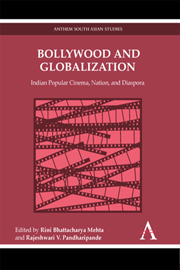Book contents
- Frontmatter
- Contents
- Acknowledgements
- Notes on Contributors
- Chapter One Bollywood, Nation, Globalization: An Incomplete Introduction
- Chapter Two Sentimental Symptoms: The Films of Karan Johar and Bombay Cinema
- Chapter Three Is Everybody Saying ‘Shava Shava’ to Bollywood Bhangra?
- Chapter Four Bollywood Babes: Body and Female Desire in the Bombay Films Since the Nineties and Darr, Mohra and Aitraaz: A Tropic Discourse
- Chapter Five Globalization and the Cultural Imaginary: Constructions of Subjectivity, Freedom & Enjoyment in Popular Indian Cinema
- Chapter Six Rang De Basanti: The Solvent Brown and Other Imperial Colors
- Chapter Seven Between Yaars: The Queering of Dosti in Contemporary Bollywood Films
- Chapter Eight Imagined Subjects: Law, Gender and Citizenship in Indian Cinema
- Chapter Nine ‘It's All About Loving Your Parents’: Liberalization, Hindutva and Bollywood's New Fathers
- Notes
- Select Bibliography
Chapter Seven - Between Yaars: The Queering of Dosti in Contemporary Bollywood Films
Published online by Cambridge University Press: 05 March 2012
- Frontmatter
- Contents
- Acknowledgements
- Notes on Contributors
- Chapter One Bollywood, Nation, Globalization: An Incomplete Introduction
- Chapter Two Sentimental Symptoms: The Films of Karan Johar and Bombay Cinema
- Chapter Three Is Everybody Saying ‘Shava Shava’ to Bollywood Bhangra?
- Chapter Four Bollywood Babes: Body and Female Desire in the Bombay Films Since the Nineties and Darr, Mohra and Aitraaz: A Tropic Discourse
- Chapter Five Globalization and the Cultural Imaginary: Constructions of Subjectivity, Freedom & Enjoyment in Popular Indian Cinema
- Chapter Six Rang De Basanti: The Solvent Brown and Other Imperial Colors
- Chapter Seven Between Yaars: The Queering of Dosti in Contemporary Bollywood Films
- Chapter Eight Imagined Subjects: Law, Gender and Citizenship in Indian Cinema
- Chapter Nine ‘It's All About Loving Your Parents’: Liberalization, Hindutva and Bollywood's New Fathers
- Notes
- Select Bibliography
Summary
The Hindi/Urdu word dosti encompasses greater intensity and devotion than the comparable English term, ‘friendship.’ Bollywood's treatments of dosti entail physical intimacy and a moral code not necessarily shared in friendships between men in the West. Ruth Vanita elaborates, ‘The continuum between romantic friendship and love is a slippery space where affection slides into or is coded as erotic without being overtly depicted as sexual.’ She draws parallels to Hollywood buddy films and remarks that Bollywood representations of dosti are also influenced by ‘older Indian traditions of same sex love.’ Cinematic dosti is a fusion of Hindu mythology, Muslim ghazals, Sanskrit and Parsi theatre, Hollywood cinema and music video. India's economic liberalization in the mid 1990s led to the introduction of satellite television on the subcontinent and a subsequent increase in imported Western pop culture. The shift from dosti as normative homosocial relationship towards the current trend of comic acknowledgement of the homoerotic undertones of dosti is tied to the recent influx of Hollywood film and American television in which homosexuality is a popular theme. Post-2000 depictions of dosti via its coupling with gay jokes is reflective of national concerns about how economic liberalization, the burgeoning middle class, Western style consumer capitalism and diasporic populations impact Indian national and diasporic values, culture and traditions.
An examination of Bollywood dosti films from the 1970s through 2004 demonstrates how the newly queered homoerotic dosti points to a possible national move away from a hegemonic heteronormativity that enforces marriage and reproduction.
- Type
- Chapter
- Information
- Bollywood and GlobalizationIndian Popular Cinema, Nation, and Diaspora, pp. 111 - 128Publisher: Anthem PressPrint publication year: 2010
- 3
- Cited by



